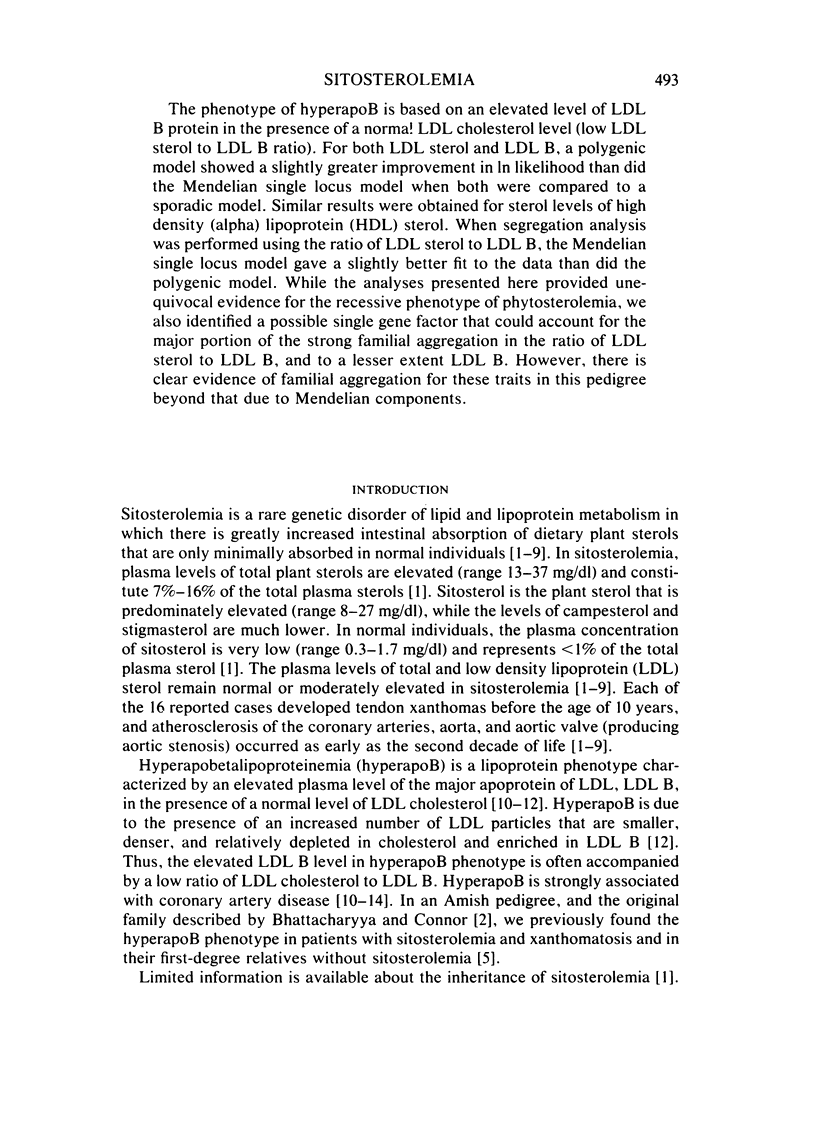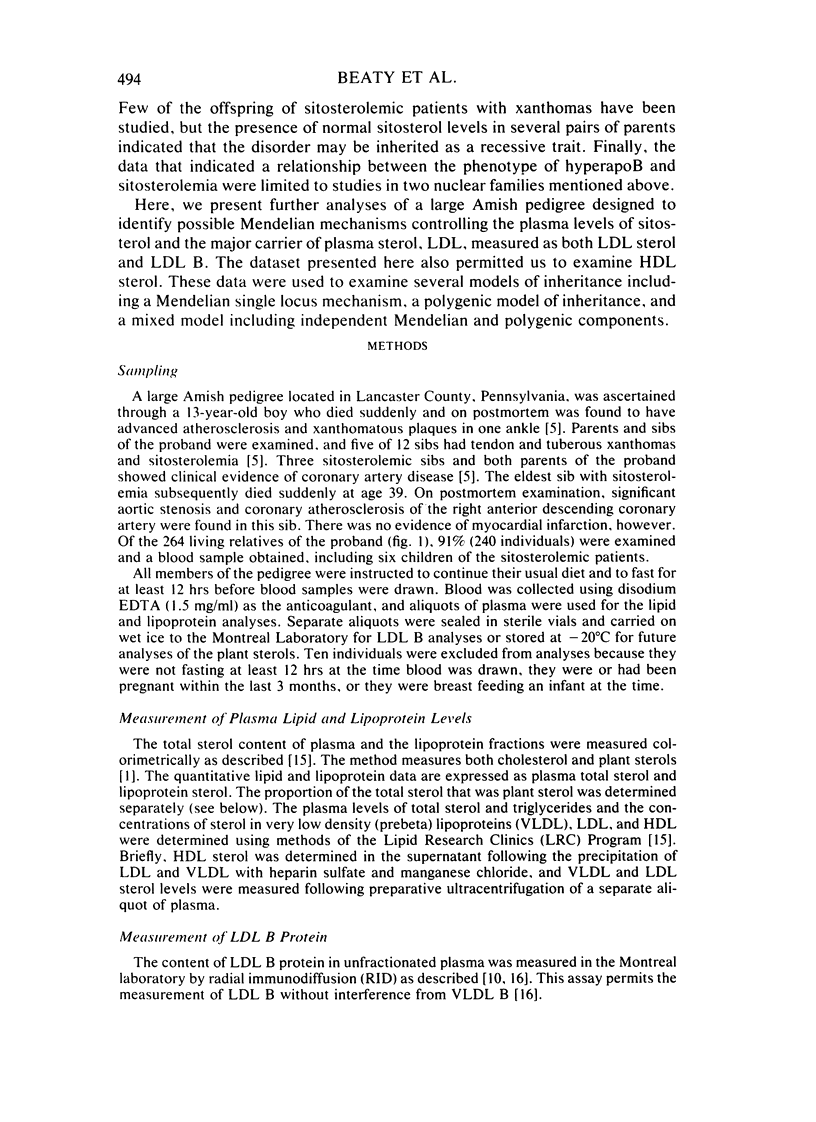Abstract
We previously reported the finding of phytosterolemia, xanthomatosis, and hyperapobetalipoproteinemia (hyperapoB) in five siblings in a large Amish pedigree ascertained through a 13-year-old boy who died suddenly from advanced coronary atherosclerosis. Here, we present further analyses of the plasma levels of the plant sterol, sitosterol, of low density (beta) lipoprotein (LDL) sterol, and of LDL B protein. Of 254 relatives and spouses of the proband, 90.5% were examined. A series of genetic models were explored using a pedigree analysis where parameters reflecting frequency, transmission, and penetrance of putative genotypes were examined simultaneously using a maximum likelihood approach. Segregation analysis of the sitosterol levels showed that the phenotype of sitosterolemia was controlled by a rare autosomal recessive gene. There was also significant familial correlation in plasma sitosterol levels that was attributed to a polygenic component under a mixed model but could also be due to shared environments such as diets. The recessive model was supported by our finding that the plasma sitosterol levels in the parents and in six children born to three of the five sitosterolemics were less than 1 mg/dl, well within the normal range. The phenotype of hyperapoB is based on an elevated level of LDL B protein in the presence of a normal LDL cholesterol level (low LDL sterol to LDL B ratio). For both LDL sterol and LDL B, a polygenic model showed a slightly greater improvement in ln likelihood than did the Mendelian single locus model when both were compared to a sporadic model. Similar results were obtained for sterol levels of high density (alpha) lipoprotein (HDL) sterol. When segregation analysis was performed using the ratio of LDL sterol to LDL B, the Mendelian single locus model gave a slightly better fit to the data than did the polygenic model. While the analyses presented here provided unequivocal evidence for the recessive phenotype of phytosterolemia, we also identified a possible single gene factor that could account for the major portion of the strong familial aggregation in the ratio of LDL sterol to LDL B, and to a lesser extent LDL B. However, there is clear evidence of familial aggregation for these traits in this pedigree beyond that due to Mendelian components.
Full text
PDF












Selected References
These references are in PubMed. This may not be the complete list of references from this article.
- Bhattacharyya A. K., Connor W. E. Beta-sitosterolemia and xanthomatosis. A newly described lipid storage disease in two sisters. J Clin Invest. 1974 Apr;53(4):1033–1043. doi: 10.1172/JCI107640. [DOI] [PMC free article] [PubMed] [Google Scholar]
- Brunzell J. D., Sniderman A. D., Albers J. J., Kwiterovich P. O., Jr Apoproteins B and A-I and coronary artery disease in humans. Arteriosclerosis. 1984 Mar-Apr;4(2):79–83. doi: 10.1161/01.atv.4.2.79. [DOI] [PubMed] [Google Scholar]
- Campeau L., Enjalbert M., Lespérance J., Bourassa M. G., Kwiterovich P., Jr, Wacholder S., Sniderman A. The relation of risk factors to the development of atherosclerosis in saphenous-vein bypass grafts and the progression of disease in the native circulation. A study 10 years after aortocoronary bypass surgery. N Engl J Med. 1984 Nov 22;311(21):1329–1332. doi: 10.1056/NEJM198411223112101. [DOI] [PubMed] [Google Scholar]
- Hasstedt S. J. A mixed-model likelihood approximation on large pedigrees. Comput Biomed Res. 1982 Jun;15(3):295–307. doi: 10.1016/0010-4809(82)90064-7. [DOI] [PubMed] [Google Scholar]
- Ishikawa T. T., MacGee J., Morrison J. A., Glueck C. J. Quantitative analysis of cholesterol in 5 to 20 microliter of plasma. J Lipid Res. 1974 May;15(3):286–291. [PubMed] [Google Scholar]
- Kwiterovich P. O., Jr, Bachorik P. S., Smith H. H., McKusick V. A., Connor W. E., Teng B., Sniderman A. D. Hyperapobetalipoproteinaemia in two families with xanthomas and phytosterolaemia. Lancet. 1981 Feb 28;1(8218):466–469. doi: 10.1016/s0140-6736(81)91850-x. [DOI] [PubMed] [Google Scholar]
- Lin H. J., Wang C., Salen G., Lam K. C., Chan T. K. Sitosterol and cholesterol metabolism in a patient with coexisting phytosterolemia and cholestanolemia. Metabolism. 1983 Feb;32(2):126–133. doi: 10.1016/0026-0495(83)90216-0. [DOI] [PubMed] [Google Scholar]
- Mellies M. J., Ishikawa T. T., Glueck C. J., Bove K., Morrison J. Phytosterols in aortic tissue in adults and infants. J Lab Clin Med. 1976 Dec;88(6):914–921. [PubMed] [Google Scholar]
- Mellies M., Glueck C. J., Sweeney C., Fallat R. W., Tsang R. C., Ishikawa T. T. Plasma and dietary phytosterols in children. Pediatrics. 1976 Jan;57(1):60–67. [PubMed] [Google Scholar]
- Miettinen T. A. Phytosterolaemia, xanthomatosis and premature atherosclerotic arterial disease: a case with high plant sterol absorption, impaired sterol elimination and low cholesterol synthesis. Eur J Clin Invest. 1980 Feb;10(1):27–35. doi: 10.1111/j.1365-2362.1980.tb00006.x. [DOI] [PubMed] [Google Scholar]
- Salen G., Ahrens E. H., Jr, Grundy S. M. Metabolism of beta-sitosterol in man. J Clin Invest. 1970 May;49(5):952–967. doi: 10.1172/JCI106315. [DOI] [PMC free article] [PubMed] [Google Scholar]
- Salen G., Kwiterovich P. O., Jr, Shefer S., Tint G. S., Horak I., Shore V., Dayal B., Horak E. Increased plasma cholestanol and 5 alpha-saturated plant sterol derivatives in subjects with sitosterolemia and xanthomatosis. J Lipid Res. 1985 Feb;26(2):203–209. [PubMed] [Google Scholar]
- Shulman R. S., Bhattacharyya A. K., Connor W. E., Fredrickson D. S. Beta-sitosterolemia and xanthomatosis. N Engl J Med. 1976 Feb 26;294(9):482–483. doi: 10.1056/NEJM197602262940907. [DOI] [PubMed] [Google Scholar]
- Sniderman A. D., Wolfson C., Teng B., Franklin F. A., Bachorik P. S., Kwiterovich P. O., Jr Association of hyperapobetalipoproteinemia with endogenous hypertriglyceridemia and atherosclerosis. Ann Intern Med. 1982 Dec;97(6):833–839. doi: 10.7326/0003-4819-97-6-833. [DOI] [PubMed] [Google Scholar]
- Sniderman A., Shapiro S., Marpole D., Skinner B., Teng B., Kwiterovich P. O., Jr Association of coronary atherosclerosis with hyperapobetalipoproteinemia [increased protein but normal cholesterol levels in human plasma low density (beta) lipoproteins]. Proc Natl Acad Sci U S A. 1980 Jan;77(1):604–608. doi: 10.1073/pnas.77.1.604. [DOI] [PMC free article] [PubMed] [Google Scholar]
- Sniderman A., Teng B., Jerry M. Determination of B protein of low density lipoprotein directly in plasma. J Lipid Res. 1975 Nov;16(6):465–467. [PubMed] [Google Scholar]


